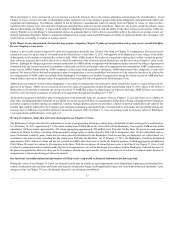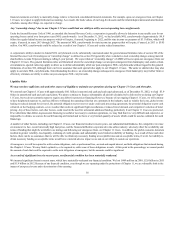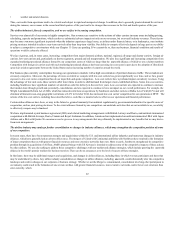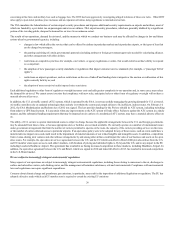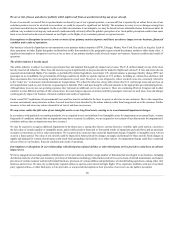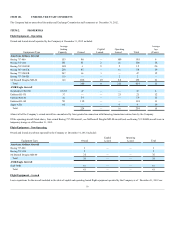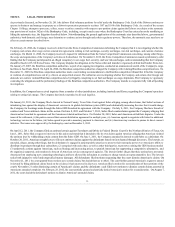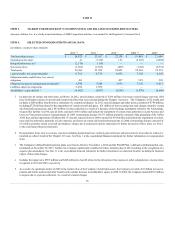American Airlines 2012 Annual Report Download - page 26
Download and view the complete annual report
Please find page 26 of the 2012 American Airlines annual report below. You can navigate through the pages in the report by either clicking on the pages listed below, or by using the keyword search tool below to find specific information within the annual report.
Our ability to operate and grow our route network in the future is dependent on the availability of adequate facilities and infrastructure
throughout our system and, at some airports, adequate slots.
In order to operate our existing flight schedule and, where appropriate, add service along new or existing routes, we must be able to obtain adequate gates,
ticketing facilities, operations areas, slots (where applicable) and office space. Also, as airports around the world become more congested, we cannot always be
sure that our plans for new service can be implemented in a commercially viable manner, given operating constraints at airports throughout our network.
Further, our operating costs at airports at which we operate, including our major hubs, may increase significantly because of capital improvements at such
airports that we may be required to fund, directly or indirectly. In some circumstances, such costs could be imposed by the relevant airport authority without
our approval.
Access to landing and take-off rights, or “slots,” at several major U.S. airports and many foreign airports served by us are subject to government regulation.
Certain of our major hubs in the United States and our most important international destinations, including London's Heathrow Airport, are among the most
congested airports in the world and have been or could be the subject of regulatory action that might limit the number of flights and/or increase costs of
operations at certain times or throughout the day. We currently have sufficient slots or similar authority to operate our existing flight schedule and have
generally been able to acquire the necessary rights to expand flights and to change our schedules. There is no assurance, however, that we will be able to do so
in the future because, among other reasons, such allocations are subject to changes in government policy. For example, the FAA is planning a new rulemaking
in 2013 to modify the current rules limiting flight operations at New York's JFK and LaGuardia airports, where we have major operations. Any limitation on
our ability to acquire or maintain adequate gates, ticketing facilities, operations areas, slots (where applicable) and office space could severely constrain our
operations and have a material adverse effect on us.
Our international operations are subject to economic and political instability and could be adversely affected by numerous events, circumstances
or government actions beyond our control.
We operate a global business with operations outside of the United States from which we derived approximately 40 percent of our operating revenues in 2012,
as measured and reported to the DOT. Our current international activities and prospects could be adversely affected by our Chapter 11 Cases, as well as
factors such as reversals or delays in the opening of foreign markets, exchange controls, currency and political risks (including changes in exchange rates and
currency devaluations, which are more likely in countries with exchange controls such as Venezuela, which recently devalued its currency, and Argentina),
environmental regulation, increases in taxes and fees and changes in international government regulation of our operations, including the inability to obtain or
retain needed route authorities and/or slots. Fluctuations in foreign currencies can significantly affect our operating performance, as well as the value of our
assets and liabilities located outside the United States.
We could be adversely affected by an outbreak of a disease that affects travel behavior.
An outbreak of a disease that affects travel demand or travel behavior, such as Severe Acute Respiratory Syndrome, avian flu, H1N1 virus or other illness, or
travel restrictions or reduction in the demand for air travel caused by similar public health threats in the future, could have a material adverse impact on us. In
addition, such events could result in quarantines of our personnel or an inability to access facilities or our aircraft, which could materially adversely affect us.
We could be adversely affected if we are unable to have satisfactory relations with any unionized or other labor work group, or if we suffer
employee strikes, slowdowns or other labor-related disruptions.
Our business is labor intensive. To the extent that we are unable to have satisfactory relations with any labor work group (unionized or independent), our
operations and our ability to execute our strategic plans could be adversely affected.
The majority of our employees are represented by labor unions and covered by collective bargaining agreements. Relations with such labor organizations are
governed by the Railway Labor Act (RLA). Under this act, the collective bargaining agreements among the Company's subsidiaries and these organizations
generally do not expire but instead become amendable as of a stated date. If either party wishes to modify the terms of any such agreement, it must notify the
other party in the manner prescribed under the RLA and as agreed to by the parties. Under the RLA, after receipt of such notice, the parties must meet for
direct negotiations, and, if no agreement is reached, either party may request the National Mediation Board (NMB) to appoint a federal mediator. The RLA
prescribes no set timetable for the direct negotiation and mediation process. It is not unusual for those processes to last for many months, and even for several
years. If no agreement is reached in mediation, the NMB in its discretion may declare at some time that an impasse exists, and if an impasse is declared, the
NMB proffers binding arbitration to the parties. Either party may decline to submit to arbitration. If arbitration is rejected by either party, a 30-day “cooling
off” period commences. During that period (or after), a Presidential Emergency Board (PEB) may be established, which examines the parties' positions and
recommends a solution. The PEB process lasts for 30 days and is followed by another “cooling off” period of 30 days. At the end of a “cooling off” period,
unless an agreement is reached or action is taken by Congress, the labor organization may exercise “self-
26



